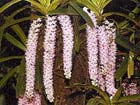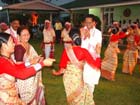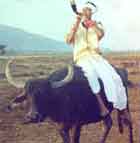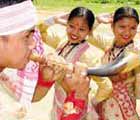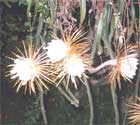Bihu is the most important non-religious festival of the Assam and is
observed by all irrespective of class and caste. There are three Bihuís.
In April it is Bohag Bihu , in October/November it is Kati Bihu and in
January it is Magh Bihu. The Bihu festival celebrates the three seasons
of spring, important to the largely pastoral people of Assam.
Bohag Bihu, the most important Bihu of all the three, is celebrated in the
month of Bohaag (middle of April), the first month of the Assamese
calendar and thus marks the advent of the Assamese New Year.
The Bohaag Bihu ushers in the period of greatest enjoyment and the
spring season. Gay spirit of spring marks the celebration of Bohaag
Bihu, which continues for three days. It marks the advent of seeding time,
the "Kaati Bihu" marks the completion of sowing and transplanting
of paddies, and the "Maagh Bihu marks the end of the harvesting period.
Bohaag Bihu is also called the "Rongali Bihu" or the
Festival of Merriment. Rong in Assamese means joy.
As merriment predominates the celebrations. Magh Bihu is
also called "Bhogali Bihu" or the Festival of Food. The Kaati
Bihu is also known as "Kongaali Bihu" or the Festival of the Poor.
On the eve of the Bihu the womenfolk clean the clothes and prepare special
Bihu delicacies like 'Chira', Pitha, etc. In the rural areas the men folk
remain busy in collecting necessary items such as 'Tara Pogha' (ropes for the cattle)
prepared out of slices of 'Tara' - (an indigenous creeper) and vegetables such
as raw turmeric, brinjal, gourd etc for the next days 'Garu Bihu'.
The first day of the Bihu is dedicated to the cattle (Goru), as cows
and bullocks provide them with means of livelihood. On this day, early
in the morning the cows and bullocks are ceremonially bathed in a
river and ponds. Their feet are washed; horns and hoofs are painted various
colours and are adorned with flower garlands. Cut pieces of the vegetables
like brinjal, gourd etc. are offered to them. Their old ropes are cut and they
are let loose for the day. On this day, they are permitted to pasture in any
field without restraint. On returning from the river verybody takes a special bath and
the younger people seek the blessings of their elders. In the evening,
when the cows return home, they are tied with new ropes (Pogha)
and are entertained with cakes especially
prepared for them. Some people also light oil lamps and incense
in the cowsheds to ward off mosquitoes and illness.
On the next day, called Manuh Bihu, special dishes made of flattened
rice, curds, and jaggery and sweets are prepared and eaten.
On this day 'Bihu Husori' is formally inaugurated at the Namghar (Prayer
hall).
The Bihu is a community festival. People visit each otherís houses,
distribute sweets to their neighbours and hold grand feasts. Rongali
Bihu inspires unbounded joy and enthusiasm expressed through Bihu
dances, songs and other festivities.
The third day is called Gosain Bihu and is dedicated to the
worship of deities.
On all three days of the festival, troupes of musicians and dancers
visit houses and perform the Bihu dance in the open. The
young boys and girls wear new clothes on this day and after enjoying
the special preparations of the Bihu, spend the time in egg fight ('Koni
Juj'), singing songs of love and romance. Such gatherings are called
"Mukoli Bihus" (Open Bihus). The songs are very popular
among all sections of the people. The folk songs associated with the
Bohaag Bihu are called "Bihu Geets" or Bihu songs. Young
men and women perform bihu dances and sing to the accompaniment of
drums and pepa, a flute made of buffalo horns. Fairs are organized at
different places and the mood of festivity is present everywhere.
Where available the girls decorate their long hair with Ko-pou flowers.
On the last two days of Bihu, as a mark of respect a gamocha (a
traditional Assamese hand-woven cotton towel with red designs with a
white background) is given to elders and their good wishes are sought in return.
Gamosa forms an integral part of the Bohaag Bihu celebrations as the male danseuse
wears them on the head as well as on the body. The tradition of presenting a
Gamosa is also practised while welcoming any guest during anytime of
the year.Japi Ė a traditional Bamboo hat with colorful designs is another item
which forms an integral part of the Bihu celebrations and is also
symbolic of Assamese Culture. A more simple bamboo Japi is normally
worn by the farmer while cultivating in the field protecting oneself
from the sun and rain.
In the cities due to the pressure of of modern day life the modes of Bihu celebrations
have changed to a great extent. Mukoli Bihus are not common any more.
In towns and cities, there are well-organized Clubs, Bihu
committees and Associations which organises Bihu festivals where
professional and amateur groups perform. Various contests
are also organized where young men and women compete in Bihu dancing
and the best dancer of each category is awarded the title. But, in most
of the rural areas its originality and emotions of Bihu are very much
alive.
Besides the Assamese, various tribes in the state, too, celebrate Bihu.
The Bodos observe it as Baisagu, Karbis as Johang Pula, Deoris as Bahagiya Bihu,
Rabhas as Nava Barasa, Tiwas as Bisu and Tai Phakes as Pasni Bihu.
See also Magh
Bihu (January) and Kati Bihu (October).
Festivals and Fairs |
   |
